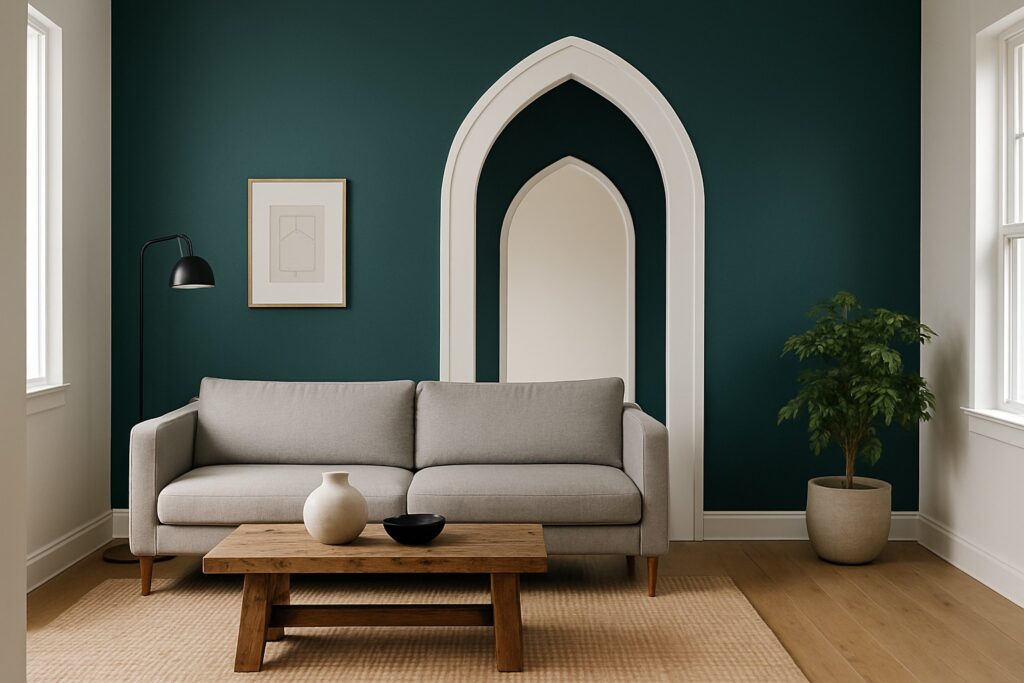Imagine stepping across a threshold and feeling as if you’ve wandered into a storybook great hall, with tapestries swaying softly and sconces flickering against rugged stone. Medieval-inspired interiors deliver that sense of romance and permanence, yet they’re surprisingly achievable in 21st-century homes.
Below, you’ll find 12 design elements that defined castles for centuries, along with stylist-approved tips for bringing each one to life.
Arches
Pointed Gothic arches first appeared in 12th-century Europe, allowing cathedrals to soar skyward while distributing weight more efficiently than Roman semicircles.
Frame a doorway with a peel-and-stick foam arch kit or removable MDF molding. You can also paint an arch silhouette on a flat wall in a contrasting hue for immediate architectural drama. For renters, place an arch-top freestanding mirror behind a sofa or entry table.
Bare Floors
Medieval halls featured rough stone or wide-plank timber floors. This made them easy to sweep off rushes and hearth embers.
Expose original hardwood, then finish with a matte wax for period authenticity. For concrete slabs, use masonry stain in mottled grays to mimic castle flagstones. Layer braided jute or wool runners where comfort is essential.
Castle Colors
Natural pigments produced deep reds from madder root, forest greens from verdigris, and rich golds with saffron or tin alloy leaf.
Paint a feature wall in oxblood or deep emerald; keep adjacent walls parchment-light for balance. Introduce gold through picture frames, cord tassels, or brass switch plates.
Test dark shades on poster-board swatches first. Small rooms may need slightly grayer undertones to avoid feeling cramped.
Chunky Furniture
Oak trestle tables and four-poster beds signified wealth and stability; their weight deterred theft during restless times.
Swap a delicate coffee table for a beefy, turned-leg bench reclaimed from farmhouse stock. In bedrooms, add a faux canopy with heavy drapery rings, even if the bed frame is modern.
Beyond just furniture, status was often displayed through armaments. Incorporating decorative pieces like a helmet on a bookshelf or a full suit of medieval armor in a grand entryway can serve as a powerful focal point.
Copper Pots
Copper conducted heat evenly over open hearths, so cauldrons and pans were prized possessions.
Hang mismatched thrift-store copper on a pot rack for an authentic, lived-in vignette. Use smaller pieces as planters for kitchen herbs.
Dark Wood
Oak, walnut, and chestnut were abundant, and dark oils protected surfaces from smoke and candle soot.
Strip factory varnish, then apply walnut-tone gel stain and finish with beeswax for depth. Contrast dark beams with off-white walls to keep spaces bright.
Monthly buffing with orange oil prevents cracking, especially in drier, heated homes.
The Hearth & Fireplace
The great hearth was the social and culinary center of medieval life.
Surround an electric insert with stick-on cast-stone veneer for a weekend DIY makeover. Install a salvaged timber mantel and chisel faux pegs for authenticity.
No chimney? Style a bioethanol tabletop “fire bowl” on a stone slab and flank with wrought iron tools for ambiance.
Heavy Fabrics
Alt text: Elegant beige sofa with velvet cushions beneath vintage floral tapestry.
Tapestries and velvets kept drafts at bay and proclaimed household status.
Hang a tapestry behind the sofa by mounting it on a curtain rod so the fabric can breathe. Swap lightweight linen pillows for damask or brocade covers each autumn.
Upholstery-grade velvet remnants make luxe cushion covers with minimal sewing.
Long Curtains
Floor-to-ceiling textiles softened stone walls and retained warmth, while also providing privacy in castles where chambers often had multiple occupants.
Mount rods 6 to 8 inches above the window frame and let panels pool slightly for drama. Choose grommet-top velvet or heavy linen in muted jewel tones.
Forged-look metal rods in matte black or russet reinforce the period vibe.
Stone Accents
Alt text: Modern hallway with stone wall, wooden console, and minimalist decor.
Every castle featured load-bearing stone, from granite in Scotland to limestone in France.
Cover a fireplace chase or breakfast-nook half wall with peel-and-stick faux stone panels. For renters, lean a large slate tile sheet behind a console table as textural art.
Wall Sconces
Iron candle sconces lined corridors long before overhead fixtures existed. Hardwire dimmable LED sconces that mimic candle flames; look for hammered-metal backplates. Battery-operated puck-light sconces offer a no-drill alternative for apartments.
Choose enclosed “flame” bulbs to avoid naked filaments near tapestries.
Wrought Iron Details
Blacksmiths forged everything from gate latches to chandelier hooks. Replace modern brass cabinet pulls with twisted iron handles. Suspend a six-arm candelabra over the dining table, using faux candles to keep cleanup easy.
Spray-paint existing metal hardware with satin black enamel for an instant upgrade.
Frequently Asked Questions
Is medieval décor expensive?
It can be, as hand-forged iron and real stone aren’t cheap. However, smart DIYs, second-hand treasures, and faux finishes can keep budgets in check.
Can I mix medieval style with modern minimalism?
Absolutely. Think one statement piece per room: a stone fireplace in an otherwise simple living space, or sleek black cabinetry accented by copper cookware.
Will dark colors make my room feel smaller?
Dark walls can recede visually, but balance is key. Use lighter trim, ample lighting, and reflective surfaces like mirrors to maintain an airy feel.
Your Home, Your Castle
Whether you choose to paint a single Gothic arch or transform an entire room, medieval design offers a blend of history, craftsmanship, and warmth.
Start small by swapping a light fixture, unfurling a tapestry, or suspending a few gleaming copper pans. Watch each room evolve into a space worthy of legend.

